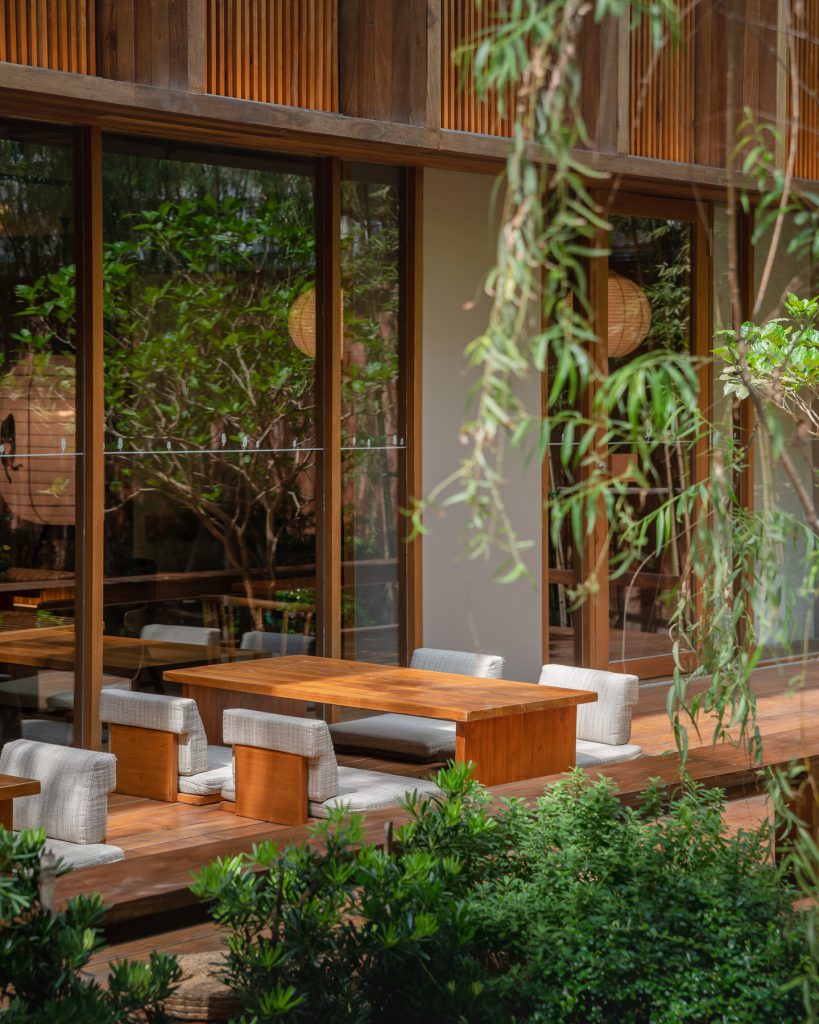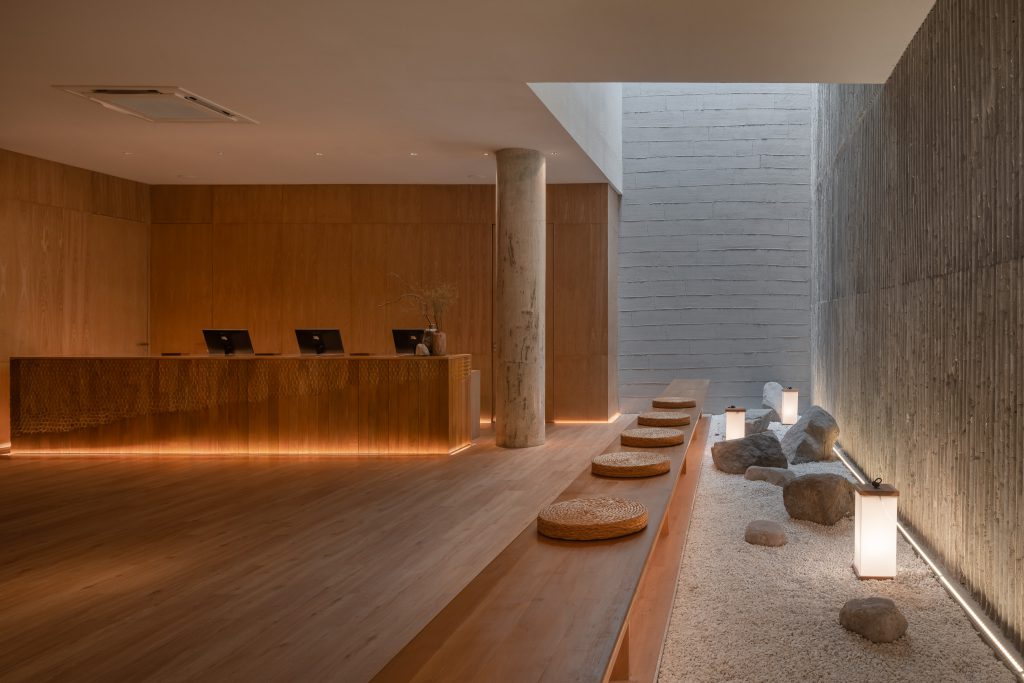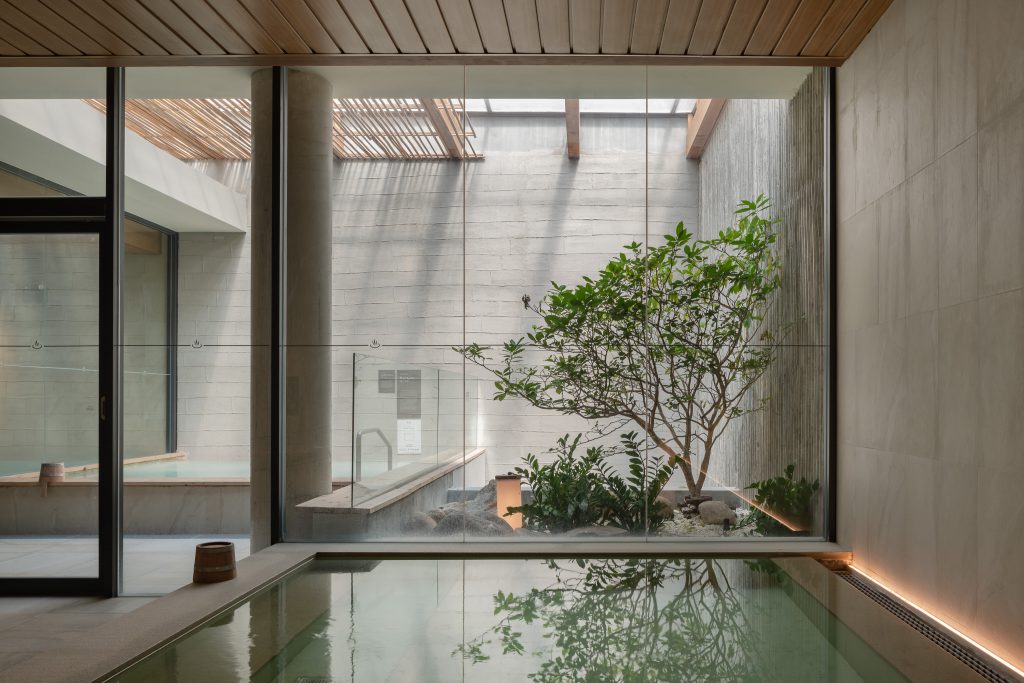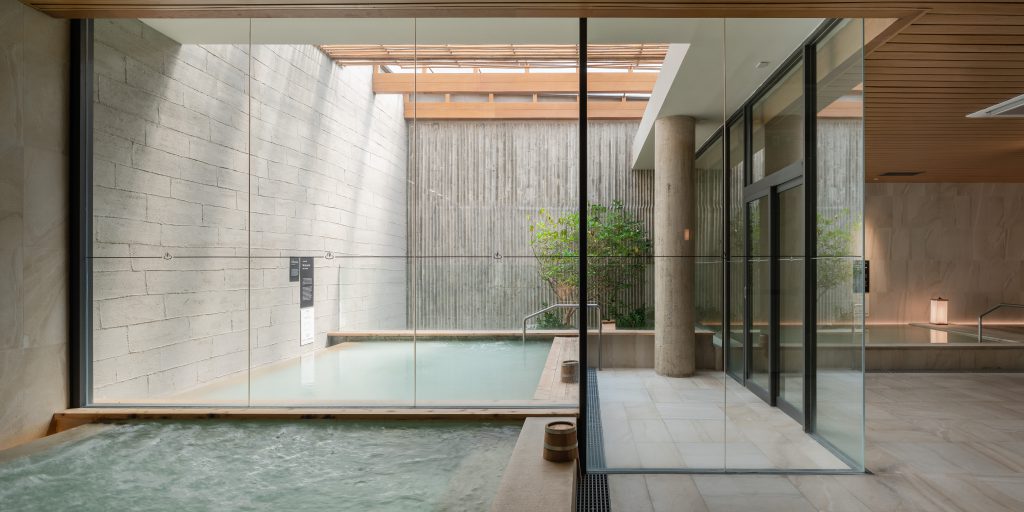In the new Onsen and spa in Sathorn, Sixseven Studio has masterfully curated various types of sensory experiences which allows users to feel physically and emotionally relaxed.
Text: Phornnipa Wongprawmas
Photo: W Workspace
Download the online journal Issue 01 The ComfortZone Click here

Photo: W Workspace
การรับรู้และสัมผัส (Sensation) ส่งผลต่อพฤติกรรม อารมณ์ และความรู้สึก การสัมผัสเพียงอย่างเดียวคงไม่ก่อให้เกิดการตอบสนองหากปราศจากการรับรู้ในสัมผัส ส่วนการรับรู้จะเกิดขึ้นได้ก็ต่อเมื่อมีสิ่งเร้าในปริมาณที่มากพอ ชีวิตประจำวันของทุกคนมีการรับสัมผัสตลอดเวลาผ่านอวัยวะและระบบสัมผัสต่างๆ (Sensory System) ความเหนื่อยล้าก็เป็นอีกหนึ่งความรู้สึกสัมผัสที่เกิดขึ้นกับร่างกาย การมีสถานที่ที่มีกิจกรรมรองรับต่อการพัก และมีสภาพแวดล้อมที่เอื้อต่อการฟื้นฟูจิตใจนั้นเป็นตัวช่วยในการผ่อนคลายจากการใช้ชีวิตประจำวันที่แสนเร่งรีบ
แนวความคิดข้างต้นได้ถูกสื่อสารออกมาทางสถาปัตยกรรม โดยคุณปกรณ์ รัตนสุธีรานนท์ สถาปนิกหลักจาก Sixseven Studio- 67s ผู้รับหน้าที่ออกแบบให้กับ Yunomori Onsen & Spa ตั้งแต่สาขาแรกที่สุขุมวิท 26 ที่เน้นการออกแบบสื่อถึงวัฒนธรรมญี่ปุ่น ส่วนสาขาสองที่พัทยาที่เน้นการออกแบบสื่อถึงวัฒนธรรมไทย เพื่อเน้นตอบสนองความต้องการให้กับลูกค้าชาวต่างชาติ และล่าสุดในสาขาบนถนนสาทร ซอย 10 นี้ ต้องการผสมผสานสองวัฒนธรรมเข้าไว้ด้วยกัน จุดเริ่มต้นของการออกแบบ Yunomori Onsen & Spa สาขาสาทร ซอย 10 เกิดจากเจ้าของโครงการมีความต้องการใช้ที่ดินเก่าที่เคยถูกใช้เป็นโกดังและอาคารพาณิชย์ ซึ่งเดิมมีอาคารเก่าจำนวน 3 อาคาร นำมาปรับปรุงเป็นสถานที่สำหรับพักผ่อนหย่อนใจของผู้อยู่อาศัยและหนุ่มสาวออฟฟิศโดยรอบ ผู้ใช้บริการสามารถใช้ชีวิตตลอดทั้งวันในโครงการได้ เนื่องจากมีบริการทั้งโรงอาบน้ำ บ่อออนเซ็น นวดแผนไทย สปา และร้านอาหาร โดยเป็นการนำโปรแกรมมาจาก Super Sento ประเทศญี่ปุ่น รวมถึงความต้องการนำเสนอศาสตร์แห่งการบำบัดอย่างการแช่น้ำร้อนออนเซ็นแบบญี่ปุ่นกับการนวดแผนไทยที่ถูกนำมาตีความหมายให้แตกต่างจากสองสาขาแรก โดยเป็นการสื่อถึงการอยู่ร่วมกันของสองวัฒนธรรมที่ผสมผสานกันได้อย่างสมดุล
พื้นที่ลานกลางแจ้งระหว่าง อาคารเก่าและอาคารใหม่
Photo: W Workspaceพื้นที่ลานกลางแจ้งถูกรายล้อมด้วยพื้นที่สีเขียวและวัสดุธรรมชาติ
Photo: W Workspace
แรกเริ่มสถาปนิกพยายามเก็บอาคารเก่าไว้ทั้ง 3 อาคาร แต่ด้วยเงื่อนไขข้อจำกัดด้านต่างๆ ทำให้ในที่สุดโปรแกรมใหม่คงเหลืออาคาร 8 ชั้นทางด้านหลังไว้เพียงอาคารเดียวเพื่อใช้สำหรับกิจกรรมนวดแผนไทย สปา ส่วนพื้นที่นั่งพักผ่อน และร้านอาหาร ส่วนอาคารด้านหน้าที่ถูกสร้างขึ้นใหม่ใช้สำหรับส่วนโถงต้อนรับ บ่อออนเซ็น โรงอาบน้ำ ห้องสตรีมและซาวน่า และมีพื้นที่สวนกลางแจ้งถูกโอบล้อมไว้ระหว่างสองอาคาร สถาปนิกจึงออกแบบพื้นที่และกิจกรรมที่สอดคล้องกับสภาพอาคาร โดยการใช้ประโยชน์อาคารเก่ากับกิจกรรมที่เอื้อต่อการจัดการงานระบบที่ต้องใช้การแก้ไขปรับปรุงที่ไม่ซับซ้อนมากนัก และสร้างอาคารใหม่เพื่อใช้ประโยชน์สำหรับกิจกรรมที่ต้องมีการเตรียมโครงสร้างและงานระบบโดยเฉพาะ รวมถึงการใช้พื้นที่เปิดโล่งระหว่างอาคารเพื่อเชื่อมโยงอาคารเก่าและอาคารใหม่ให้มีบรรยากาศต่อเนื่องกัน
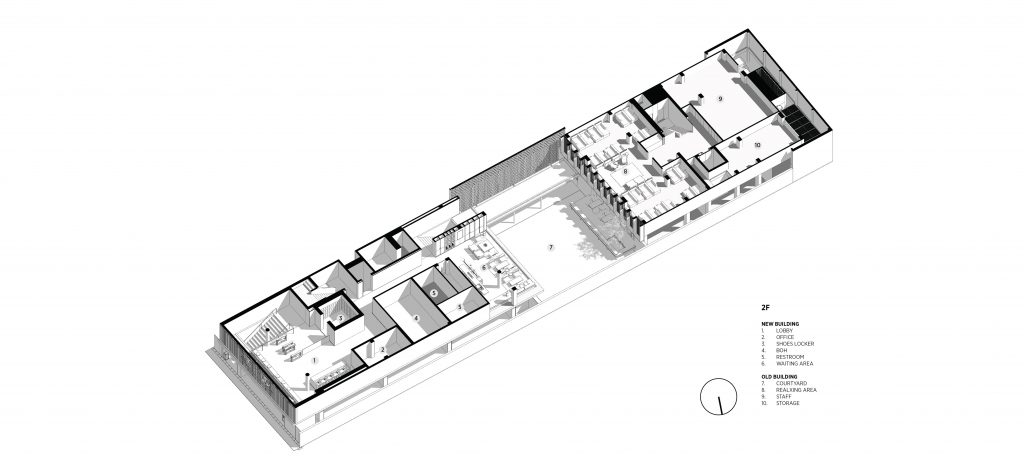
Photo: W Workspace
สถาปนิกพยายามออกแบบเพื่อสร้างการรับรู้และสัมผัสของโครงการนี้ในทุกพื้นที่ ตั้งแต่ส่วนพื้นผิวเปลือกอาคารใหม่ (Façade) ของอาคารด้านหน้าโครงการ ซึ่งเป็นส่วนที่สร้างความท้าทายให้กับทั้งสถาปนิก ทีมงาน และฝีมือช่าง เนื่องจากเป็นการสร้างสรรค์พื้นผิวใหม่ให้กับวัสดุประเภทคอนกรีต โดยใช้เทคนิคการนำไม้ไผ่มาประกอบเป็นแม่แบบ แต่ข้อจำกัดคือไม้ไผ่แต่ละท่อนมีความโก่งงอไม่เท่ากันตามคุณสมบัติของวัสดุธรรมชาติ รวมถึงระยะของนั่งร้านที่ไม่เพียงพอที่จะให้ช่างใช้แรงในการแกะไม้ไผ่ พื้นผิวจึงเกิดการแตกกระเทาะเป็นบางจุดจนต้องใช้เนื้อปูนเพื่อเก็บรอยซ่อมแซม ปัจจัยเหล่านี้ทำให้พื้นผิวเปลือกอาคารอาจไม่สวยสมบูรณ์แบบ แต่ในมุมมองของสถาปนิก มันคือเสน่ห์ของพื้นผิววัสดุที่เกิดขึ้นยามเมื่อกระทบแสง สถาปนิกได้ให้ความหมายกับงานออกแบบส่วนนี้ว่าเปรียบเสมือนผิวดินที่หยาบหรือผุกร่อนจากสภาวะแวดล้อมภายนอก
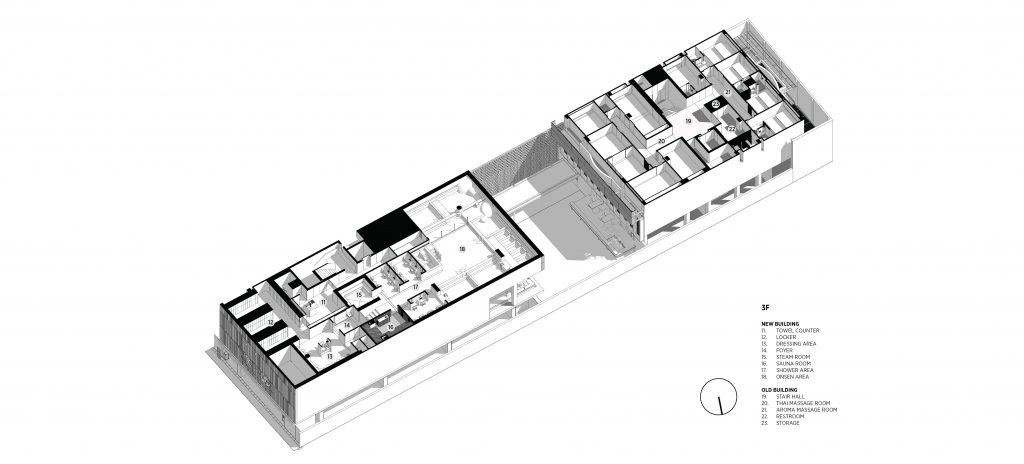
Photo: W Workspace
เมื่อเข้าสู่ภายในอาคาร สถาปนิกตั้งใจร้อยเรียงการรับรู้ผ่านผิวสัมผัสของวัสดุและความมืดความสว่างจากทั้งแสงประดิษฐ์และแสงธรรมชาติ โดยจากส่วนโถงต้อนรับ (Lobby) ที่ตกแต่งด้วยไม้ธรรมชาติและการใช้แสงไฟที่ไม่สว่างมากนัก เปรียบเสมือนบรรยากาศภายในเตาเครื่องปั้นดินเผา ต่อเนื่องไปตามโถงทางเดิน (Corridor) ที่แคบและยาวด้วยแสงที่สลัวเพื่อเตรียมตัวเปลี่ยนผ่านไปสู่พื้นที่โถงนั่งพักคอยหลัก (Waiting Area) ที่เปิดมุมมองกว้างและมีการเปิดช่องแสงธรรมชาติจากด้านบนอาคารเพียงช่องเดียวของอาคารด้วยเงื่อนไขทางด้านกฏหมายแนวร่นอาคารและการเปิดที่โล่งระหว่างอาคารเก่ากับอาคารใหม่ สามารถมองเห็นพื้นที่สวนภายนอกด้านล่างที่ทำหน้าที่เป็นจุดเชื่อมต่อไปสู่อาคารเก่า การเลือกใช้อิฐเป็นวัสดุหลักในการตกแต่งพื้นและผนังเพื่อสร้างสีสันที่โดดเด่นออกจากพื้นที่สีเขียวโดยรอบ โอบล้อมผู้ใช้พื้นที่ก่อนเข้าสู่ภายในอาคารเก่าที่ถูกเชื้อเชิญด้วยพื้นที่นั่งพักผ่อน (Relaxing Area) ที่ยังคงเชื่อมต่อบรรยากาศกับพื้นที่สีเขียวในลานกลางแจ้ง
บรรยากาศรอบๆโถงต้อนรับ สีสันอบอุ่นจากแสงไฟสลัว
Photo: W Workspaceส่วนโถงต้อนรับภายในอาคารเลือกใช้วัสดุเลียนแบบธรรมชาติ ปิดผิวอาคาร
Photo: W Workspace
นอกจากการสื่อสารแนวความคิดของการรับรู้ที่ผ่อนคลายผ่านพื้นที่ใช้สอย สถาปนิกได้พยายามสื่อสารผ่านภาษาของวัสดุและเทคนิควิธีการที่สร้างสรรค์ขึ้นใหม่โดยเฉพาะ เช่น เทคนิคการปาดเกรียงบนผิวพ่นทรายเพื่อให้เกิดการสลับลวดลาย การใช้พื้นผิววัสดุที่ดิบกระด้างแต่เรียงตัวซ้ำเพื่อสร้างมิติให้กับพื้นที่ การเลือกใช้แสงบรรยากาศที่ไม่สว่างมากนักเพื่อเป็นสิ่งเร้าทางประสาทสัมผัสให้กับผู้ใช้พื้นที่ สถาปนิกเปรียบการสื่อสารนี้เสมือนการซ่อมแซมถ้วยชามที่แตกหักหรือสึกหรอให้กลับมาใช้งานได้ เป็นการทำให้สิ่งนั้นกลับมามีชีวิตอีกครั้งตามแนวคิด คินสึงิ (Kintsugi) จนเกิดเป็นความงามที่ไม่สมบูรณ์แบบตามแนวปรัชญาแบบ วะบิ-ซะบิ (Wabi-Sabi) แต่เป็นการถ่ายทอดด้วยการใช้อัตลักษณ์และการตีความจากแนวปรัชญาเพื่อสร้างความหมายใหม่ให้กับพื้นที่
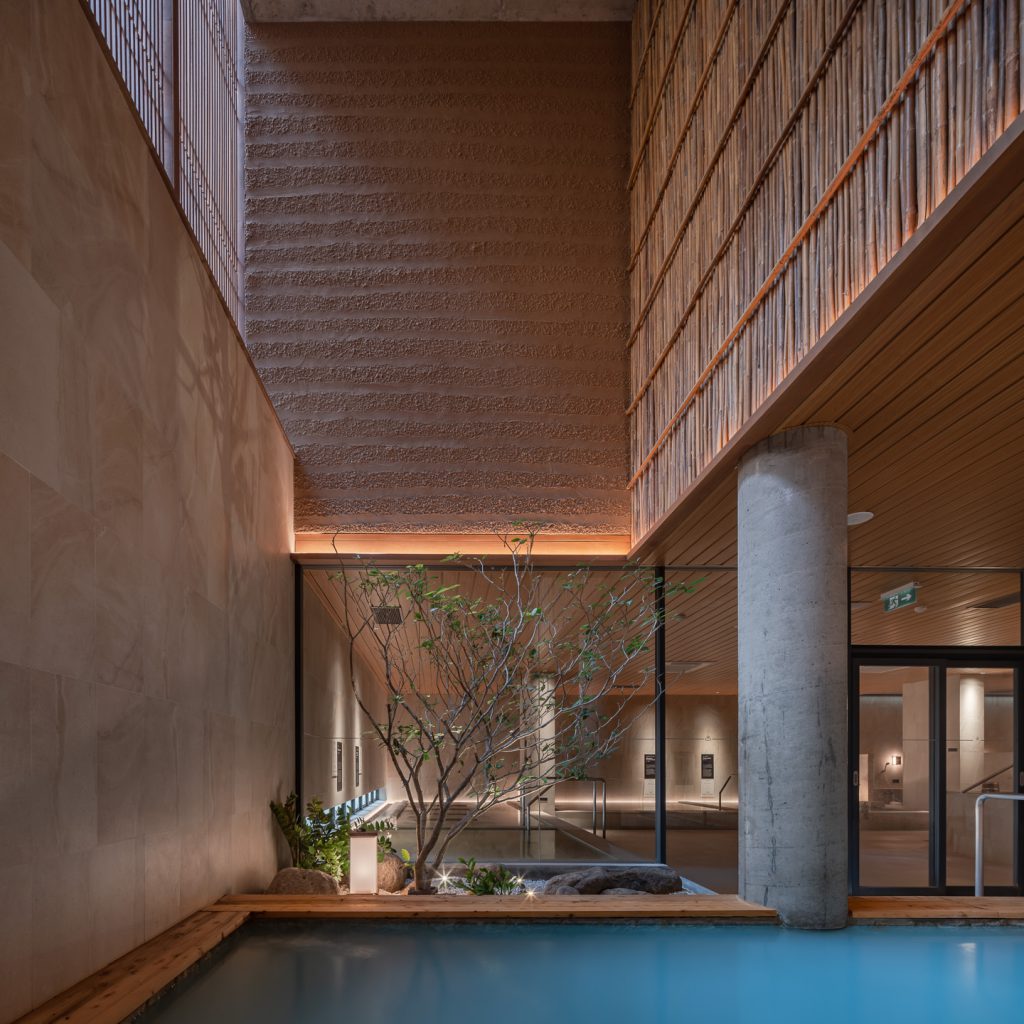
Photo: W Workspace
การสร้างลำดับการรับรู้และสัมผัสตลอดการเข้าถึงพื้นที่ส่วนต่างๆ ผ่านการแปรเปลี่ยนจากผิวเปลือกภายนอกอาคารที่เป็นมวลใหญ่และผิววัสดุดิบกระด้างที่สุด นำเข้าไปสู่ภายในอาคารแต่ละพื้นที่ ที่มีการเลือกใช้รูปแบบและขนาดของพื้นที่ที่แคบยาวสู่พื้นที่เปิดกว้าง ไปจนถึงพื้นที่เปิดโล่งสู่พื้นที่สีเขียว รวมถึงการค่อยๆ ลดทอนความหยาบของวัสดุ การคลี่คลายจากลวดลายที่เล็กและหยาบ ไปสู่ลวดลายที่ใหญ่ขึ้นและมีผิวสัมผัสที่เนียนละเอียด นับว่าเป็นวิธีการจัดสภาพแวดล้อมเพื่อกระตุ้นระบบสัมผัสที่ครอบคลุมมิติในระดับต่างๆ เป็นการใช้พื้นที่และสภาพแวดล้อมเพื่อเป็นเครื่องมือและสิ่งเร้าในการสร้างความผ่อนคลาย (Relaxing Sensation) เป็นการให้ความหมายกับ Comfort Zone ในลักษณะของพื้นที่อำนวยความสะดวกด้านการรับรู้และสัมผัส (Sensory Space) ทำให้ผู้ใช้พื้นที่ไม่เพียงแต่ผ่อนคลายทางกายจากการใช้บริการด้านต่างๆ ของโครงการ แต่ยังคงรู้สึกผ่อนคลายและฟื้นฟูจิตใจผ่านการบอกเล่าในรูปแบบสถาปัตยกรรม ที่ผู้ออกแบบพยายามตีความและถ่ายทอดให้เห็นว่ารูปแบบของความงามที่ไม่สมบูรณ์ตามที่ตาเห็น สามารถทำให้เกิดความงามที่มีอารมณ์และความรู้สึกเป็นเครื่องรับสัมผัสได้อย่างไร
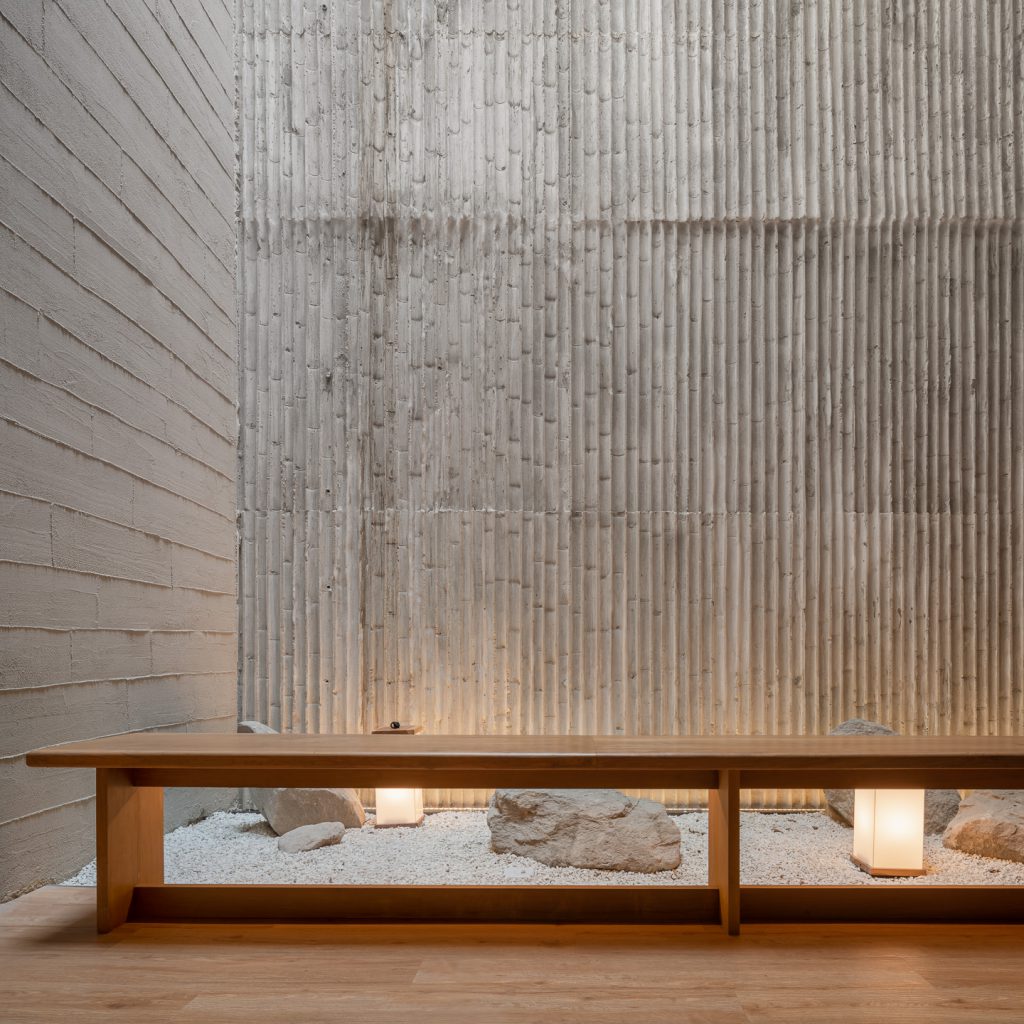
Photo: W Workspace
Yunomori Onsen & Spa Sathorn 10
‘Sensations’ have specific impacts on people, behaviors, emotions and feelings. It takes both physical contact and perceptions of such communications for a reaction to take place. And for such a perception to happen, there needs to be enough stimulants. In humans’ daily life, our organs and sensory systems enable constant sensations. Exhaustion is one of the sensations that a human body can experience. Therefore, having a space with activities and services that allow people to feel physically and mentally rehabilitated is crucial, especially with the modern lifestyle which encourages people to go through the hasty pace of everyday life.
The concept mentioned above gets translated into a work of architecture by Pakorn Rattanasuteeranon. The principal architect of Sixseven Studio-67s is the mind behind the design of the first Yunomori Onsen & Spa located on Soi Sukhumvit 26 Street in Bangkok and the Pattaya branch that later followed. With the first branch, the design takes inspiration from Japanese culture, while the second branch uses Thai aesthetics to cater to the target clientele that mainly comprises of foreigners. With the brand’s latest addition on Sathon Soi 10 Street, the architect fuses the characteristics of both cultures into the design of the architectural structure and spaces.
พื้นที่ส่วน Onsen จากภายในอาคารที่รับแสงจากธรรมชาติ
Photo: W Workspaceการสร้างความเชื่อมต่อทางสายตากับพื้นที่ภายนอกและเปิดรับแสงธรรมชาติเข้ามา
ภายในอาคารช่วยสร้างการรับรู้ถึงเวลาและธรรมชาติรอบตัว
Photo: W Workspace
The design of the most recent branch of Yunomori Onsen & Spa in Sathorn begins with the project’s owner’s wish to use transform the old piece of land occupied by a cluster of structures (a warehouse and shophouses) into a space that offers the experience of pure relaxation for the residents and office workers in the area. Yunomori Onsen & Spa’s patrons can spend an entire day inside the project and enjoy their services, ranging from a bathhouse, onsen, Thai massage to a spa and a restaurant. With the Japanese spa chain ‘Super Sento’ as the model, the establishment offers users ancient sciences of health and well-being such as Japanese onsen and Thai massage as parts of its program. The new interpretation sets Yunomori Onsen & Spa Sathorn 10 apart from the brand’s first two branches since the design expresses an equilibrium of coexistence and fusion between the two cultures.
Initially, the architect had attempted to preserve all three original buildings. Nevertheless, due to surrounding conditions and limitations, the only remaining original structure in the new program is the eight-story building located to the back of the property. The building was renovated and is now housing Thai massage and spa services, the lounge area, and the restaurant. Situated toward the front is a newly constructed building, which hosts the reception area, onsen pools, a bathing facility, steam rooms and saunas with a courtyard linking the two quarters together. The architect designs the functional spaces and activities to correspond with the physical conditions of the program. The old building hosts activities that do not require complex systems to work and manage. Meanwhile, the new building is designed to accommodate the services that need special preparations for the structures, functional spaces and system works, whereas the open space between the two built structures helps facilitate a harmonious atmosphere for the entire program.
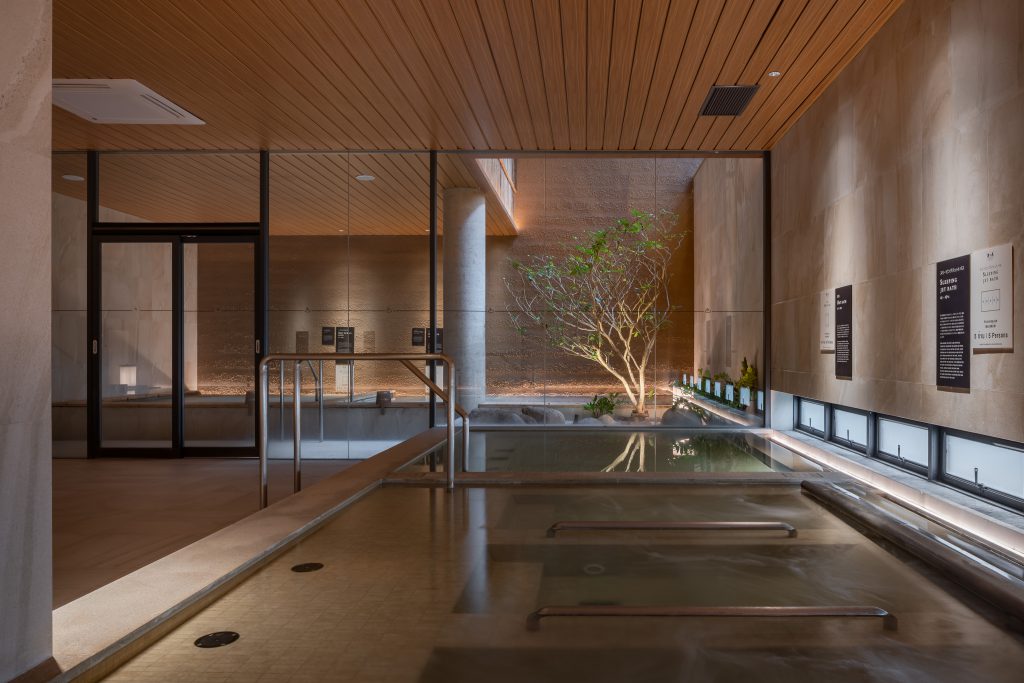
Photo: W Workspace
The architect creates a design that curates the sensations of the way users can experience different functional spaces. With the new façade, having to create an entirely new surface on the concrete materials required the team to build bamboo molding. However, the limitation came from the bamboo stems. Since they have different bending angles due to their natural physical attributes. Not only that, the range between the facade structure and the scaffolding wasn’t enough to provide the force the builders needed to take off the mold, causing the surface to crack. The facade required additional touch-ups to fix parts of the finishing, resulting in its partially flawed texture. But for the architect, who has given meaning to this part of the design by comparing it to the natural coarseness and deterioration of earth, the imperfection becomes the charm, especially when light touches the surface.

Photo: W Workspace
As one enters the building, the hierarchy of spatial experiences gradually reveals itself through the materials’ different textures and brightness levels brought about by natural and artificial light. Decorated with natural wood and lit with moderate illumination, the lobby gives off the ambiance that’s akin to the one inside of a kiln. It leads toward the long, narrow and dimly lit corridor, transitioning into the main waiting area that is spacious and bathed in natural light. The sun finds its way in through the only opening (a result of the allowed setback and space between an existing and new building as indicated in building laws and regulations), which grants visual access to the outside garden and the old building. The use of bricks as the primary material of floor and wall decoration creates an outstanding contrast to the surrounding green space. A ‘relaxing area’ welcomes visitors into the other building while the natural element of the outdoor green space is still very much present.
The relaxing sensation is communicated through different functional spaces. Materials and the newly invented construction techniques are the design language that the architect utlizes to translate the concept. We can see and feel the design accent through the pattern created from the use of scraping tool on the sand wash finish, the repetitive order of raw and rigid surfaces that bring dimensional visuals to space, and the way the ambient light stimulates users’ sensory experiences and its interaction with functional areas. The architect compares his communication approach to mending a broken plate, giving something back its life. It follows the Kintsugi philosophy and creates imperfect beauty, which is a part of the Wabi-Sabi philosophy. The expressed identity and interpretation from the Japanese philosophy ends up bringing a new meaning to the curated space of Yunomori Onsen & Spa.

Photo: W Workspace
The design creates a hierarchy of perception and sensory experience in different parts of the program through the transition from the building’s facade’s sizeable mass and coarse texture to the interiors. The changes of interior spaces happen through the gradual shift of scales and forms, from a long and narrow walkway to an open, spacious waiting room and then to the green area of the garden. The materials’ rawness and rigidity unhurriedly reconcile, from the coarse texture with small details to big patterns with a clean, smooth surface. It’s the manifestation of the architect’s masterful approach in managing the environment to effectively stimulate users’ sensory systems, enabling them to encompass different dimensions and levels of one’s experience of the program. The design can utilize spaces and environments as a tool and stimulant and create a relaxing sensation. It gives meaning to the word ‘comfort zone’ in the sense of a sensory space, which facilitates users’ meaningful and positive sensory experiences. It allows users to feel physically relaxed by the place’s services while emotionally decompressed and rehabilitated by the architecture’s storytelling. The design of Yunomori Onsen & Spa is a story of how visually imperfect beauty is interpreted and expressed into the kind of aesthetic where emotions, feelings, and sensory experiences work in a unified yet incredibly dynamic collective.



